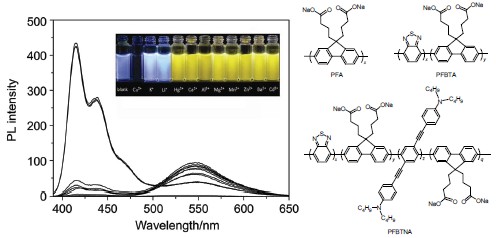| [1] Zhu, C. L.; Yang, Q.; Liu, L. B.; Wang, S. Prog. Chem. 2011, 23, 1993.[2] Zhu, S. J.; Zhang, J. H.; Song, Y. B.; Zhang, G. Y.; Zhang, H.; Yang, B. Acta Chim. Sinica 2012, 70, 2311. (朱守俊, 张俊虎, 宋玉彬, 张国彦, 张皓, 杨柏, 化学学报, 2012, 70, 2311.)[3] Deng, H. P.; Wang, G. J.; Zhu, B. S.; Zhu, L. J.; Wang, D. L.; Zhuang, Y. Y.; Zhu, X. Y. Acta Chim. Sinica 2012, 70, 2507. (邓洪平, 王国建, 朱邦尚, 朱利娟, 王大力, 庄园园, 朱新远, 化学学报, 2012, 70, 2507.)[4] Chen, Y. G.; Xu, B. M.; He, Z. K.; Xie, W. H. Acta Chim. Sinica 2011, 69, 1361. (陈彦国, 徐保明, 何治柯,谢卫红, 化学学报, 2011, 69, 1361.)[5] Duan, X. R.; Liu, L. B.; Feng, F. D.; Wang, S. Acc. Chem. Res. 2010, 43, 260.[6] Jiang, H.; Taranekar, P.; Reynolds, J. R.; Schanze, K. S. Angew. Chem. Int. Ed. 2009, 48, 4300.[7] Lu, L. D.; Helgeson, R.; Jones, R. M.; McBranch, D.; Whitten, D. J. Am. Chem. Soc. 2002, 124, 483.[8] Jones, R. M.; Bergstedt, T. S.; McBranch, D. W.; Whitten, D. G. J. Am. Chem. Soc. 2001, 123, 6726.[9] Wu, X. F.; Xu, B. W.; Tong, H.; Wang, L. X. J. Polym. Sci. Part A: Polym. Chem. 2012, 50(8), 1521. [10] Ren, X. S.; Xu, Q. H. Langmuir 2009, 25(1), 29.[11] Sanji, T.; Nakamura, M.; Tanaka, M. Tetrahedron Lett. 2011, 52(26), 3283. [12] Chan, Y. H.; Jin, Y. H.; Wu, C. F.; Chiu, D. T. Chem. Commun. 2011, 47(10), 2820.[13] Liu, B.; Bazan, G. C. Chem. Mater. 2004, 16, 4467.[14] Wosnick, J. H.; Mello, C. M.; Swager, T. M. J. Am. Chem. Soc. 2005, 127, 3400.[15] Zheng, J.; Swager, T. M. Chem. Commun. 2004, 2798.[16] Wang, B.; Wasielewski, M. R. J. Am. Chem. Soc. 1997, 119, 12.[17] Bao, B. Q.; Yuwen, L.; Zhan, X. W.; Wang, L. H. J. Polym. Sci. Part A: Polym. Chem. 2010, 48(15), 3431.[18] Bao, B. Q.; Yuwen, L. H.; Zheng, X. N.; Weng, L. X.; Zhu, X. R.; Zhan, X. W.; Wang, L. H. J. Mater. Chem. 2010, 20(43), 9628.[19] Che, Y.; Pu, K. Y.; Fan, Q. L.; Qi, X. Y.; Huang, Y. Q.; Lu, X. M.; Huang, W. J. Polym. Sci. Part A: Polym. Chem. 2009, 47, 5057.[20] Pu, K.; Zhan, R.; Liang, J.; Liu, B. Sci. China-Chem. 2011, 54(4), 567.[21] Pu, K. Y.; Liu, B. Adv. Funct. Mater. 2009, 19(2), 277.[22] Chi, C. Y.; Mikhailovsky, A.; Bazan, G. C. J. Am. Chem. Soc. 2007, 129(36), 11134.[23] Satrijo, A.; Swager, T. M. J. Am. Chem. Soc. 2007, 129, 16020.[24] Pu, K. Y.; Liu, B. Macromolecules 2008, 6636.[25] Qin, C.; Wu, X.; Gao, B.; Tong, H.; Wang, L. Macromolecules 2009, 5427.[26] Xing, C. H.; Shi, Z. Q.; Yu, M. H.; Wang, S. Polymer 2008, 49, 2698.[27] Nolan, E. M.; Lippard, S. H. Chem. Rev. 2008, 108, 3443.[28] Yu, M. H.; He, F.; Tang, Y.; Wang, S.; Li, Y. L.; Zhu, D. B. Macromol. Rapid Commun. 2007, 28, 1333.[29] Prodi, L.; Bolletta, F.; Montalti, M.; Zaccheroni, N. Coord. Chem. Rev. 2000, 205, 59.[30] Zhang, M.; Lu, P.; Ma, Y. G.; Shen, J. C. J. Phys. Chem. B 2003, 107, 6535.[31] Yasuda, T.; Yamamoto, T. Macromolecules 2003, 36, 7513.[32] Wang, W. L.; Xu, I. W.; Lai, E. H. J. Polym. Sci. Part A: Polym. Chem. 2006, 44, 4154.[33] Vetrichelvan, M.; Valiyaveettil, S. Chem.-Eur. J. 2005, 11, 5889. |
